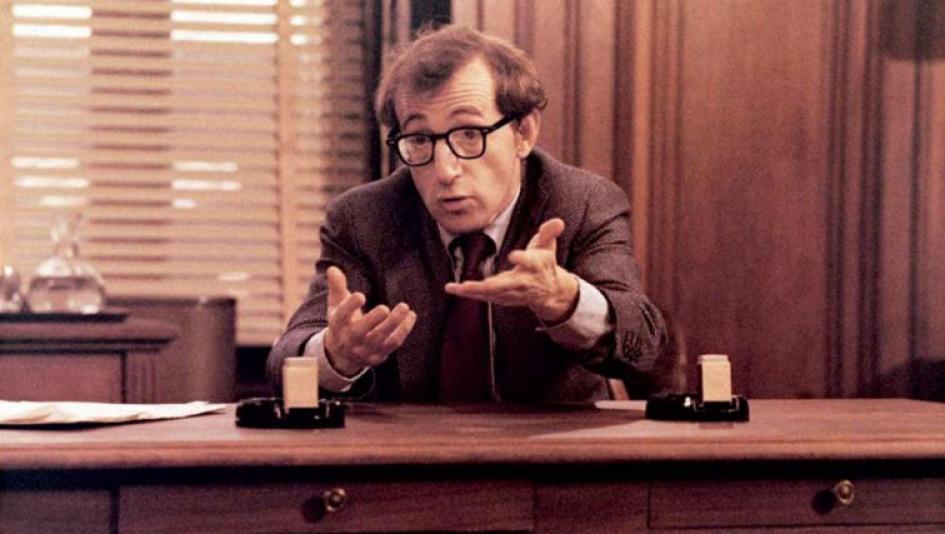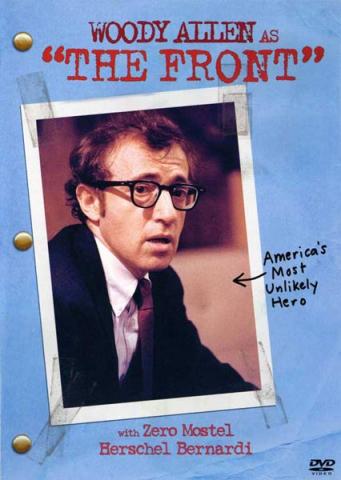
The Rivalry That Never Was: Rachel Alexandra and Zenyatta

Woody Allen playing Howard Prince in "The Front".
The 1976 film “The Front” opens with a shot of a young Woody Allen perched on a barstool reading the Daily Racing Form. Allen plays the fictional Howard Prince, a down-on-his-luck Brooklyn bookmaker who is asked to front for a group of blacklisted television writers. Set in the 1950s, “The Front” was based on the real-life experiences of Walter Bernstein, the film’s Oscar-nominated writer.
In the film, Howard Prince is recruited by an old high school friend to pretend to write his and other communist and communist-sympathizers’ screenplays so they can earn a living. He has no political leanings of his own, but Prince agrees since he had been booking more winning bets than losers, and needs the money. (A very young Danny Aiello plays one irate customer Prince has yet to pay)
The film is worth watching for a look back at a strange and not-so-distant moment in American history, and for one of Woody Allen’s only film appearances in a movie he did not write or direct. But Walter Bernstein’s memoir, “Inside Out”, contains a great anecdote about a day at the racetrack with an acquaintance, Martin Ritt, who would end up directing “The Front” for Bernstein many years later. Bernstein was crashing on Martin’s couch in a small apartment in Manhattan that he shared with his wife, Adele.
“At that time neither Ritt nor I was working. Adele had a job selling space in the Yellow Pages, but that brought in very little. I slept on the living room couch and did the cooking. Marty supported us with his gambling. He won money playing poker, betting on ball games and handicapping horses. He always knew what he was doing and he was very good at it. He was the only gambler I ever knew who gambled to win. Sentiment never attracted or diverted him; he had no other agenda. He showed as little emotion losing as winning. His temper never interfered. He never exulted when he won or complained when he lost. The only time I ever saw him show emotion while gambling was the first time he took me to the track. I had never been before and knew nothing of horse racing, but I went armed with the picks from the newly installed handicapper for the Daily Worker. The Communist newspaper had just decided to broaden its appeal to the masses, and I figured that included me. I won six dollars. Marty lost all his bets. He was enraged by what he saw as a political betrayal, although I was never sure whether he was mad at me or the Communist Party. He was always mad at the Communist Party, usually for the right reasons.”

The Daily Worker was a popular newspaper among leftists in New York City for much of the first half of the 20th century. It was published by the American branch of the Communist Party and, at its peak, had a circulation of 35,000. In the mid-1930s, the paper hired Lester Rodney to help it develop a sports page. In addition to covering horse racing, Rodney also wrote blistering critiques of the color barrier in professional baseball, one of the first journalists to challenge that status quo.
While Rodney’s handicapper might have had a good day on the afternoon Bernstein and Ritt went to the races, he never achieved quite the acclaim his British counterpart did in 1949 during that year’s Grand National. Writing under the name Cayton (perhaps a pseudonym?), the British communists’ handicapper was known for picking longshots, and in that year’s Grand National he once again asked his readers to play against the favorite - a horse named Roimond piloted by the jockey Dick Francis. The 66-1 longshot that Cayton picked bested Francis and Roimond in the stretch and in the process perhaps lined the pockets of thousands of British communists at the expense of their capitalist Roimond-backing counterparts. The only real winner outside of the readers of the Daily Worker was probably Dick Francis. He secured a deal to write a memoir about the race, and went on to become one of the world’s greatest crime writers.
The horse that won? Russian Hero, naturally.
The Daily Worker competed with another leftist daily newspaper in New York, PM. PM gave a start to writers of such acclaim as Izzy Stone and Theodore Geisel (Dr. Seuss). But their own horse racing handicapper was none other than George F.T. Ryall, who wrote under the pen name Audax Minor. Ryall went on to become the author of “The Race Track”, the long-running weekly horse racing column in The New Yorker, and the longest-running writer in the history of the magazine, having penned the column for more than 50 straight years.
The Daily Worker published until 1986. It’s possible the horse racing column was an inspiration to another famous communist handicapper, Len Ragozin. The inventor of the famous Ragozin Sheets handicapping system was a card-carrying member of the Communist Party well past its pre-Cold War heyday and the days of the blacklist. His aunt Rachel Ragozin was a charter member of the U.S. Communist Party. His father was a horseplayer. Len Ragozin chose to dive deeper into handicapping after realizing his chosen politics wouldn’t help his career prospects as a journalist after he left Harvard.
There is no more Daily Worker, no more PM, no more “The Race Track” column in The New Yorker. There is only Walter Bernstein, who is 95 years old today. He’s still living in New York City, still writing, still in good health. Without the addition of a casino, he might even have outlived Aqueduct. Arguably, and depending on your take on state capitalism and the Chinese economy, he has even outlived communism itself.